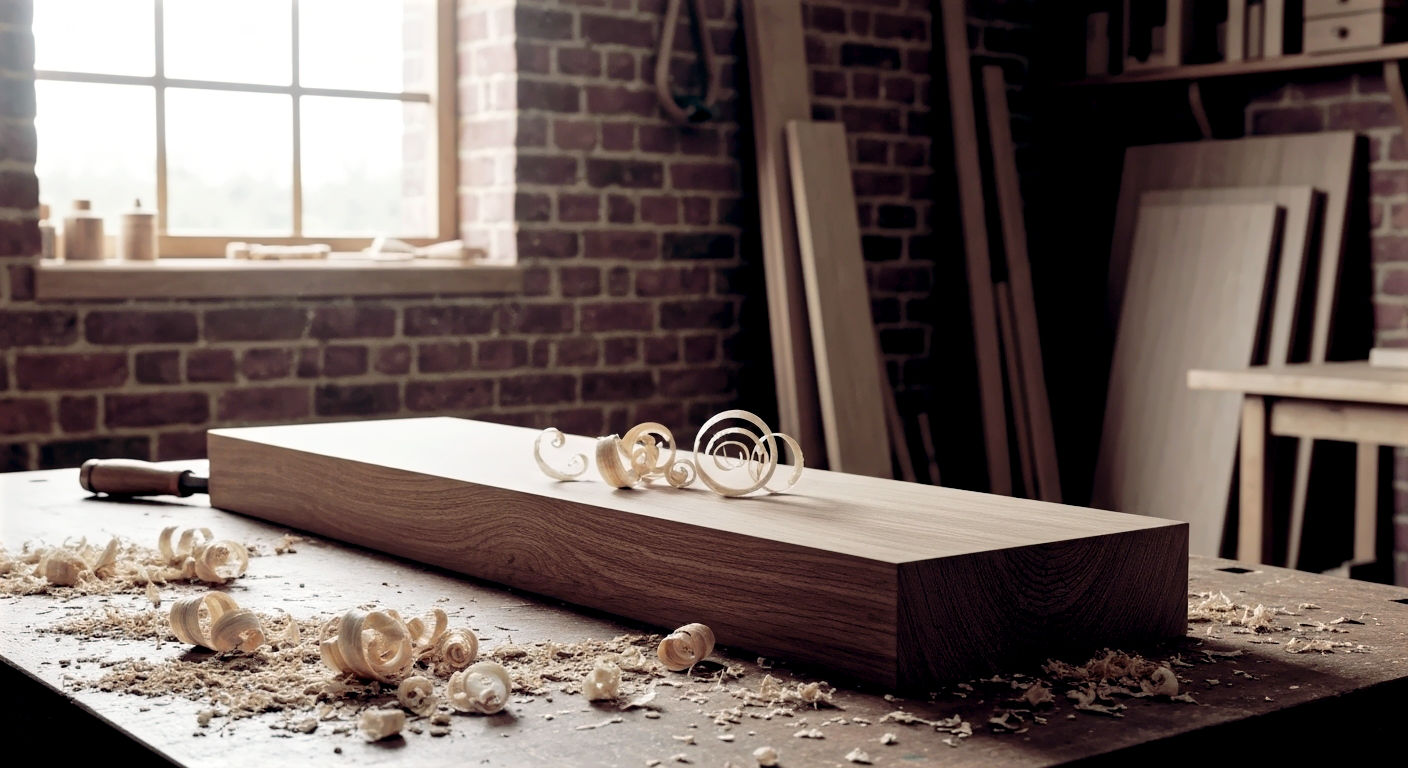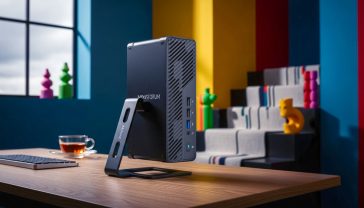The DeWalt DW733 Portable Thicknesser Review: A British Woodworker’s Guide
An exhaustive review of the DeWalt DW733 portable thicknesser. We dive into its features, performance, and value for money for UK hobbyists and tradespeople.

This post may contain affiliate links. If you make a purchase through these links, we may earn a commission at no additional cost to you.
If you’ve ever found yourself with a wonky piece of timber that you wish was perfectly flat and uniform, you’re not alone. For woodworkers up and down the UK, from chilly sheds in the Scottish Highlands to bustling workshops in London, getting wood to the right thickness is a constant challenge. It’s the difference between a wobbly table and a family heirloom. This is where a thicknesser comes in, and for many, the DeWalt DW733 is the go-to machine.
-
Designed for portability, making it suitable for job sites and small workshops.
-
Features holes in the base for secure mounting to a workbench.
-
Large infeed and outfeed tables provide material support for large pieces, helping to improve the surface finish.
-
Compatible with the DEWALT DT2074 flush cutting blade for cutting flush to an edge.
-
Equipped with a powerful 1800-watt motor to handle large surface planing with ease.
But what is a thicknesser, really? And is this bright yellow box of tricks actually any good? Think of a thicknesser as a super-precise, upside-down plane. You feed a piece of wood into one side, and it comes out the other side a little bit thinner and perfectly parallel. It’s not about making wood straight – that’s a job for a jointer – but about making it consistently thick. For anyone serious about making furniture, fitting kitchens, or just pottering in their garage, it’s a game-changer.
In this guide, we’re going to take a deep dive into the DeWalt DW733. We’ll look at where it came from, what it does, and whether it’s worth your hard-earned cash. We’ll cover everything from unboxing it to the racket it makes, and by the end, you’ll know if it’s the right tool to take your woodworking to the next level. So, grab a brew, and let’s get started.
What Exactly is a Thicknesser and Why Do You Need One?
Before we get stuck into the DW733 itself, let’s clear up what a thicknesser actually does. It’s one of those tools that sounds complicated but is actually quite simple. Its one and only job is to make a piece of wood a consistent thickness from one end to the other.
Imagine you’ve bought some rough-sawn oak from a local timber yard. It’s beautiful wood, full of character, but it’s all over the place in thickness. One end might be 28mm thick, and the other might be 32mm. If you try to build a cabinet door with that, it’ll look like something out of a funfair.
This is where the thicknesser steps in. You need to have one flat face on your piece of wood to start with (you’d typically do this with a jointer or a hand plane). Then you feed the wood into the thicknesser with the flat side down. Inside the machine, a set of rollers pulls the wood through, and a spinning block of sharp blades (the cutter head) shaves a thin layer off the top face. You can adjust the height of the cutter head to control how much wood you take off with each pass.
You keep feeding the wood through, taking off a little at a time, until you reach your desired thickness. The end result is a board that is perfectly parallel and ready for your project.
The Difference Between a Planer and a Thicknesser
Now, you might be thinking, “Isn’t that just a planer?” Well, yes and no. It’s a bit confusing because people often use the terms interchangeably, especially in the US. In the UK, we tend to be a bit more specific.
- A planer (or jointer) is used to create a flat face and a square edge on a piece of wood. It has a flat table and a cutter block that you run the wood over.
- A thicknesser (or thickness planer) is used to make the opposite face parallel to the first flat face. You feed the wood through the machine.
Some machines, called planer-thicknessers, combine both functions. But the DW733 is a dedicated thicknesser. This means it’s really good at its one job, but you’ll need another way to get that first flat face. For many hobbyists, a good hand plane or a set of winding sticks can do the trick.
Who is the DeWalt DW733 For?
So, who should be looking at a machine like this? The DW733 is what’s known as a “portable” or “lunchbox” thicknesser. It’s designed for a few specific types of people:
- The Serious DIYer or Hobbyist Woodworker: If you’ve moved beyond making things out of pre-machined timber from B&Q and want to start using rough-sawn wood, a thicknesser is a massive step up. It opens up a whole new world of possibilities and allows you to create much more professional-looking projects.
- The Small Workshop or Tradesperson: For joiners, kitchen fitters, or furniture makers working in a small space, the DW733 is ideal. It’s compact enough to sit on a workbench and can be moved out of the way when not in use. It’s perfect for taking to a job site if you need to dimension timber on the fly.
- The Woodturner or Carver: Anyone who needs to prepare their own blanks will find a thicknesser incredibly useful. It allows you to get your wood to the perfect size before you start shaping it.
It’s probably not the right machine for a large, professional workshop that’s churning out huge volumes of timber all day long. For that, you’d want a much larger, static machine. But for everyone else, the DW733 hits a sweet spot of power, precision, and portability.
The DeWalt Story: From Radial Arm Saws to Cordless Dominance
To really understand the DW733, it helps to know a little bit about the company behind it. DeWalt wasn’t born in the age of cordless drills and impact drivers. Its story starts way back in 1924, when an American inventor named Raymond E. DeWalt created the radial arm saw. This was a revolutionary machine at the time, and it set the tone for what the company would become known for: innovation and durability.
For decades, DeWalt was the king of the professional workshop. Their big, heavy, stationary machines were the gold standard for quality and reliability. If you walk into any old joinery shop in the UK today, there’s a good chance you’ll find a DeWalt radial arm saw or a crosscut saw still going strong after 50 years of hard graft.
The Black & Decker Era and the Rise of the Yellow and Black
In 1960, DeWalt was bought by Black & Decker, another giant of the tool world. For a while, the DeWalt name was associated with those big, old-school machines. But in the early 1990s, Black & Decker decided to make a big change. They wanted to create a new line of professional-grade power tools for tradespeople, and they chose the DeWalt name to lead the charge.
This was the birth of the iconic yellow and black colour scheme that we all know today. The new DeWalt tools were designed to be tough, powerful, and reliable – everything that a professional builder or carpenter needed. They were a huge success, and DeWalt quickly became one of the most respected names on job sites around the world.
DeWalt in the UK
In the UK, DeWalt tools really took off in the late 1990s and early 2000s. The construction industry was booming, and there was a huge demand for high-quality power tools. DeWalt’s range of cordless drills, saws, and grinders were a perfect fit for the British tradesperson. They were seen as a step up from the more DIY-focused brands, and the yellow and black colours became a badge of honour for serious professionals.
The DW733 fits perfectly into this story. It’s a tool that bridges the gap between the old DeWalt of big, stationary machines and the new DeWalt of portable, job-site tools. It has the power and precision that you’d expect from a professional workshop machine, but it’s been cleverly designed to be compact and portable enough for a small workshop or the back of a van. It’s a testament to DeWalt’s ability to understand what their customers need and to deliver a product that is both innovative and incredibly practical.
Unboxing the Beast: A Look at the DeWalt DW733
So, you’ve decided to take the plunge and buy a DW733. What can you expect when that big, yellow and black box arrives at your door?
The first thing you’ll notice is the weight. This is not a lightweight, plastic tool. The DW733 weighs around 33.6 kg (that’s over 5 stone in old money!), so you’ll probably need a hand to get it out of the box and onto your workbench. This weight is actually a good thing. It’s a sign that the machine is well-built, with plenty of cast iron and steel in its construction. A heavy machine is a stable machine, and that’s exactly what you want when you’re feeding big lumps of wood through it.
What’s in the Box?
Inside the box, you’ll find:
- The main thicknesser unit, fully assembled.
- A dust shroud and an adapter for connecting a vacuum extractor.
- A hex key for changing the blades.
- A handle for winding the cutter head up and down.
- The instruction manual.
The setup is incredibly simple. All you need to do is attach the handle and the dust shroud, and you’re pretty much ready to go. This is a big plus for anyone who just wants to get on with some woodworking and doesn’t want to spend hours fiddling with a complicated machine.
Build Quality and First Impressions
As soon as you get your hands on the DW733, you can tell it’s a quality piece of kit. The body is made from a combination of heavy-duty plastic and cast aluminium, and it all feels incredibly solid. This is a tool that’s designed to be thrown in the back of a van and withstand the rigours of a busy job site.
One of the standout features of the DW733’s design is the four-post column system. The entire cutter head and motor assembly moves up and down on four chunky, machined steel posts. This makes the whole mechanism incredibly stable and rigid. When you lock the cutter head in place, there is absolutely no movement, which is crucial for getting a perfectly smooth and accurate finish. Cheaper thicknessers often use a single-post or a two-post design, which can lead to a bit of wobble and a less-than-perfect cut.
The infeed and outfeed tables are another nice touch. These are large, fold-out tables that support the wood as it enters and exits the machine. This is really important for preventing “snipe.” Snipe is a common problem with thicknessers where the blades take a slightly deeper cut at the beginning and end of a board. This happens because the board can tip as it enters or leaves the machine, causing it to lift up into the blades. The large support tables on the DW733 help to keep the wood perfectly flat and level, which minimises snipe and gives you a much better finish.
The depth adjustment handle is big and easy to turn, and the thickness scale on the side of the machine is clear and easy to read. There’s also a handy material removal gauge that shows you how much wood you’re taking off with each pass. It’s these little details that make the DW733 such a user-friendly machine. You can tell that it’s been designed by people who actually use these tools and understand what’s important.
Under the Bonnet: The Nitty-Gritty of the DW733
Now that we’ve had a look at the outside of the machine, let’s delve a bit deeper and see what makes it tick. This is where the DW733 really starts to shine and where you can see why it has such a good reputation among woodworkers.
The Powerhouse: The 1800W Motor
At the heart of the DW733 is a powerful 1800-watt motor. This is a serious amount of grunt for a portable machine, and it’s what allows the DW733 to handle even the toughest of hardwoods with ease. Whether you’re feeding through a piece of soft pine or a dense slab of English oak, the motor doesn’t bog down or struggle. It just keeps on spinning, delivering a clean and consistent cut every time.
The motor spins the cutter head at a blistering 10,000 revolutions per minute (RPM). This high speed is important for a couple of reasons. Firstly, it means that the blades are taking a huge number of cuts every second, which results in a very smooth finish. Secondly, it helps to clear the wood chips away from the cutting area, which prevents the machine from getting clogged up.
It’s worth noting that this motor is loud. Very loud. We’re talking over 100 decibels, which is about the same as a chainsaw. You absolutely must wear ear defenders when using this machine, even if it’s just for a quick pass. Your neighbours might not be too pleased either, so it’s probably not a tool for late-night woodworking sessions in a terraced house!
The Cutter Head and Blades
The cutter head on the DW733 is a traditional two-blade design. It holds two straight, high-speed steel (HSS) blades that are double-sided. This is a neat feature because it means that when one side of the blades gets dull, you can simply flip them around and use the other side. This effectively doubles the life of each set of blades, which is great for your wallet.
Changing the blades is a relatively straightforward process. You use the supplied hex key to loosen a few bolts, and the blades can then be lifted out. The new blades (or the flipped old ones) sit on a set of locating pins, which ensures that they are perfectly aligned every time. This is a much better system than on some older machines where you had to use a special jig to set the blade height correctly.
While the standard HSS blades do a great job, some users choose to upgrade to a helical or spiral cutter head. These cutter heads are fitted with dozens of small, square carbide cutters that are arranged in a spiral pattern. They have a number of advantages over traditional straight blades:
- They produce a much cleaner cut, especially on figured or tricky-grained wood.
- They are much quieter in operation.
- The carbide cutters last much longer than HSS blades.
- If you do get a nick in a cutter, you can simply rotate it to a fresh edge.
Upgrading to a helical head is not cheap, but for anyone who uses their thicknesser a lot, it can be a worthwhile investment.
Key Specifications at a Glance
Here’s a quick rundown of the most important numbers for the DeWalt DW733:
| Specification | Value |
|---|---|
| Power Input | 1800 Watts |
| No Load Speed | 10,000 RPM |
| Max. Capacity | 317 mm (12.5 inches) |
| Max. Thicknessing Height | 152 mm (6 inches) |
| Max. Depth of Cut | 2 mm |
| Feed Rate | 8 m/min |
| Weight | 33.6 kg |
| Dimensions (L x W x H) | 520 x 310 x 445 mm |
The 317mm maximum capacity is a really useful feature. It means you can plane boards that are just over 12 inches wide, which is plenty for most furniture and cabinet-making tasks. The 152mm maximum thicknessing height is also very generous and allows you to work with some seriously chunky pieces of timber.
Putting It to the Test: The DW733 in Action
So, we know it’s well-built and has some impressive specs, but what’s it actually like to use? This is the most important question, and the good news is that the DW733 is a real pleasure to operate.
Setting Up for the First Cut
As we mentioned earlier, getting the machine ready for its first cut is incredibly simple. Once it’s on a stable workbench, you just need to set the depth of cut. You do this by winding the large handle on top of the machine. The pointer on the side shows you the current thickness, and you can aim for your target dimension.
A good tip is to measure the thickest part of your board with a pair of calipers and set the machine to be just slightly less than that. You want to aim to take off no more than 1-2mm per pass, especially on wider boards or hardwoods. Taking small, shallow cuts will put less strain on the motor and will give you a much better finish.
The Cutting Performance
This is where the DW733 really excels. The powerful motor and sharp blades make light work of even the most challenging woods. The finish straight off the machine is incredibly smooth, often good enough to go straight to a final sanding without any further preparation. This is a huge time-saver and is one of the main reasons why so many people love this machine.
The feed rate of 8 metres per minute feels just right. It’s fast enough to get through a lot of timber quickly, but not so fast that it compromises the quality of the cut. The rollers do a great job of pulling the wood through the machine at a consistent speed, and you don’t get any of the slipping or hesitation that you sometimes find on cheaper models.
As we discussed earlier, snipe is minimal thanks to the large infeed and outfeed tables and the rigid four-post design. You might get a tiny amount on very long boards, but for most projects, it’s practically non-existent. This is a huge advantage over many other portable thicknessers on the market.
Dust Extraction: The Achilles’ Heel?
If there’s one area where the DW733 gets mixed reviews, it’s dust extraction. The machine produces a phenomenal amount of wood chips, and you absolutely must have some form of extraction connected to it. You can’t just let it fire chips all over your workshop – you’ll be buried in a matter of minutes!
The included dust shroud has a port that can be connected to a standard workshop vacuum or a dedicated chip extractor. The problem is that the shroud itself can be a bit of a bottleneck. The chips are flying off the cutter head at a huge speed, and they can sometimes get clogged up in the shroud, especially if you’re taking a heavy cut on a wide board.
When it works, it works well. But you do need to have a powerful extractor with good airflow to keep things moving. A standard Henry-style vacuum will probably struggle. Many users find that a high-volume, low-pressure (HVLP) chip extractor is the best solution.
Some users have also modified the dust shroud to improve the airflow, or have built their own custom extraction hoods. It’s not a deal-breaker, but it’s something to be aware of. If you’re planning to buy a DW733, you should also budget for a decent dust extraction system to go with it.
Living with the DW733: Maintenance and Common Issues
Like any piece of machinery, the DeWalt DW733 needs a bit of looking after to keep it running at its best. The good news is that it’s a relatively low-maintenance tool.
Routine Maintenance
- Keep it clean: After each use, it’s a good idea to blow or vacuum all the dust and chips out of the machine. Pay particular attention to the rollers and the area around the cutter head.
- Wax the bed: Applying a coat of paste wax to the cast iron bed of the thicknesser will help the wood to slide through more smoothly and will prevent rust from forming.
- Check the blades: Regularly inspect the blades for any nicks or signs of dullness. A dull blade will put more strain on the motor and will give you a poor finish. Remember that the blades are double-sided, so you can flip them around when one side gets worn.
- Check the drive belt: Occasionally, you should check the tension and condition of the drive belt that connects the motor to the cutter head. If it’s looking worn or cracked, it’s time to replace it.
Common Problems and How to Fix Them
The DW733 is a very reliable machine, but there are a few common issues that can crop up:
- Lines or ridges on the wood: This is usually caused by a nick in one of the blades. If you see a consistent line appearing on your planed boards, it’s a sign that you need to flip or replace the blades.
- The wood is not feeding through smoothly: This is often caused by a dirty or un-waxed bed. Give the bed a good clean and apply a fresh coat of paste wax. It could also be that the rollers are slipping. You can clean the rubber rollers with a bit of white spirit to restore their grip.
- The machine is tripping the circuit breaker: This can happen if you’re trying to take too deep a cut on a wide, hard piece of wood. The motor is working overtime, and it’s drawing too much current. The solution is to reduce the depth of cut and take shallower passes.
Overall, the DW733 is a very robust and well-engineered tool. If you look after it properly, it should give you many years of faithful service.
The Verdict: Is the DeWalt DW733 Worth the Money?
After taking a close look at every aspect of the DeWalt DW733, it’s time to answer the big question: is it worth the investment?
In the UK, you can expect to pay around £500-£600 for a new DW733. This is a significant amount of money for a single tool, especially for a hobbyist woodworker. So, what do you get for your money, and is it a good value proposition?
The Pros
The Cons
How Does it Compare to the Competition?
The main competitors to the DeWalt DW733 in the UK market are machines like the Makita 2012NB and the Metabo DH 330.
The Makita is another excellent machine that is very popular with tradespeople. It’s a bit lighter than the DeWalt and is known for its quiet operation (for a thicknesser!). However, it has a slightly smaller capacity and some users report that it’s more prone to snipe.
The Metabo is a well-regarded German-made machine that is often praised for its precision and build quality. It’s in a similar price bracket to the DeWalt and offers a very similar set of features.
There are also a number of cheaper options from brands like Scheppach, Record Power, and Triton. While these machines can offer good value for money, they generally don’t have the same level of build quality, power, or finish as the DeWalt. They often use two-post designs, have smaller motors, and are more prone to snipe.
-
Designed for portability, making it suitable for job sites and small workshops.
-
Features holes in the base for secure mounting to a workbench.
-
Large infeed and outfeed tables provide material support for large pieces, helping to improve the surface finish.
-
Compatible with the DEWALT DT2074 flush cutting blade for cutting flush to an edge.
-
Equipped with a powerful 1800-watt motor to handle large surface planing with ease.
The Final Word
So, is the DeWalt DW733 worth it? For the serious DIYer, hobbyist woodworker, or small-scale professional, the answer is a resounding yes.
While it might be more expensive than some of its rivals, you are paying for a level of quality, performance, and reliability that is hard to beat. The superb finish it produces will elevate the quality of your work, and the time you save by not having to hand-plane or sand every board is invaluable.
It’s a tool that will grow with you. As your skills and ambitions as a woodworker expand, the DW733 will be right there with you, ready to take on whatever you throw at it. It’s an investment, for sure, but it’s an investment in quality, precision, and, ultimately, in the joy of making things with your own two hands. If you’re serious about woodworking, the DeWalt DW733 is a machine that you will not regret buying.
Further Reading:
- Get Woodworking: https://www.getwoodworking.com/
- The Woodworker: https://www.thewoodworkermag.com/
- UKworkshop.co.uk Forum: https://www.ukworkshop.co.uk/
- Peter Millard’s YouTube Channel (10 Minute Workshop): https://www.youtube.com/c/petermillard
- Matt Estlea’s YouTube Channel: https://www.youtube.com/c/MattEstlea







